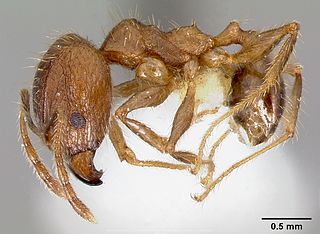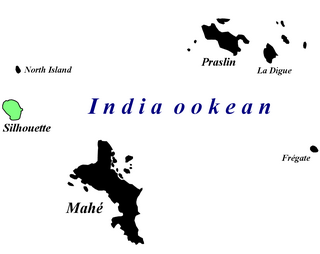
Pheidole is a genus of ants that belongs to the ant subfamily Myrmicinae. The genus is widespread and ecologically dominant. It probably includes more than 1000 species. The genus first evolved in the Americas, eventually spreading across the globe.

Ancyridris is a small genus of myrmicine ants, with only two described species from New Guinea.

Tatuidris, or armadillo ant, is a rare genus of ants consisting of a single species, Tatuidris tatusia. The ants are small in size and inhabit the leaf litter of Neotropical forests in Central and South America, from Mexico to Brazil. Workers are ferruginous-colored to dark red and present a distinctive morphology, consisting of a shield-like head with a broad vertex, ventrally-turned heavy mandibles which do not overlap at full closure, and unique among ants – an antenna socket apparatus sitting upside-down. Little is known about the biology of the ants, but they are likely nocturnal and specialist predators.

Euprenolepis is a Southeast Asian genus of ants in the subfamily Formicinae with eight recognized species.

Tyrannomyrmex is a rare tropical genus of ants in the subfamily Myrmicinae. Three similar species, only known from workers, are recognized and share small eyes and edentate mandibles.

Tyrannomyrmex legatus is a tropical Old World species of ants in the subfamily Myrmicinae. It is only known from a single worker from Sri Lanka. Gynes and males are unknown.
Pheidole komori is a species of ant in the subfamily Myrmicinae.
Pheidole parva is a species of ant in the subfamily Myrmicinae.
Pheidole ragnax is a species of ant in the subfamily Myrmicinae.

Pheidole fervens is a species of ant in the subfamily Myrmicinae. Pheidole fervens, described from Singapore, is a widespread invasive species and could be native to the Oriental or the Oceanic region.

Pheidole teneriffana is a species of ant in the subfamily Myrmicinae.
Pheidole dodo is a species of ant in the subfamily Myrmicinae. It is named after the dodo, an extinct bird of Mauritius.
Pheidole megatron is a species of ant in the subfamily Myrmicinae.
Pheidole loki is a species of ant in the subfamily Myrmicinae.
Pheidole decepticon is a species of ant in the subfamily Myrmicinae.
Pheidole vulcan is a species of ant in the subfamily Myrmicinae.

Pheidole jonas is a species of ant in the subfamily Myrmicinae.
Kempfidris is a Neotropical genus of ants in the subfamily Myrmicinae containing the single species Kempfidris inusualis. Known from Brazil, Ecuador and Venezuela, the species was originally described as Monomorium inusuale in 2007, but was reclassified as the type species for the new genus Kempfidris in 2014. The species is only known from workers and almost nothing is known about their natural history.
Pristomyrmex tsujii is a species of ant in the genus Pristomyrmex. Known from Fiji, where they are widely distributed but rarely encountered. The species has a discrete ergatoid queen caste that is intermediate between a worker and an alate queen.

Afrolychas braueri, commonly known as the Seychelles forest scorpion, is a species of scorpion in the family Buthidae. It is currently thought to survive only on Silhouette Island, Seychelles, although the species was historically found on two additional Seychellois islands. This scorpion lives in leaf litter in forests that are largely unaffected by invasive plant species. It is a small yellowish-brown scorpion with three prominent keels on the dorsal surface of its mesosoma, which distinguishes it from other scorpions. While not much is known about the Seychelles forest scorpion's ecology due to the paucity of sightings, it is known to rely solely on its venom to capture its prey and defend its young. Its venom is not dangerous to humans.










